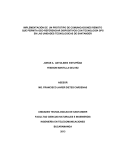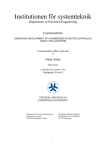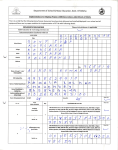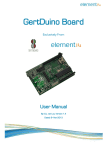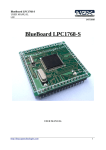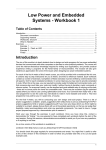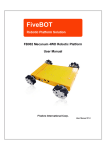Download Arduino Interrupts | uC Hobby
Transcript
Arduino Interrupts | uC Hobby
10/19/09 11:29 AM
Skip to content
uC Hobby
Microcontrollers Electronics Hobby
About
Discussions
Giveaway Program
Links
Make Controller Kit
Parts
Scrounging
FAQ
How-To: Use a Heat Gun
How-To: Work Surface
Web Rings
Log In
Search
Categories:
Arduino
Contest
Development Tools
Discovering
Electronics Links
Givaways
Hacks
Ideas
Microcontroller
Parts
Projects
Review
Scrounging
Scrounging Parts
TGIMBOEJ
uC Hobby Site
Uncategorized
Workshop Tips
Workshop Tools
Arduino Interrupts
Often when working on microcontroller projects you need a background function to run at regular intervals. This is
often done by setting up a hardware timer to generate an interrupt. The interrupt triggers an Interrupt Service
Routine (ISR) to handle the periodic interrupt. In this article I describe setting up the 8-Bit Timer2 to generate
interrupts on an Arduino ATMega168. I walk through steps required for setup and inside the ISR function.
http://www.uchobby.com/index.php/2007/11/24/arduino-interrupts/
Page 1 of 18
Arduino Interrupts | uC Hobby
10/19/09 11:29 AM
If you are following the Arduino sound articles this one will be important to read as well. Future articles will make
use of this timer feature to control frequency generation. In fact, I started to do this article as another installment
on the sound project but decided it would be best to cover timer interrupts separately.
The Arduino default processor is an ATMega168 (datasheet link). This microcontroller has several I/O systems that every Arduino user
is familiar with because the Arduino library makes using them easy. The Digital I/O, PWM, A/D Inputs, and Serial port for example. The
ATMega168 also has three internal hardware timers. While the Arduino library does make use of some of the timer features it does not
directly cover using a timer to generate periodic interrupts.
Interrupts?
As the name suggest, interrupts are signals that interrupt the normal flow of a program. Interrupts are usually used for hardware
devices that require immediate attention when events occur. For example the serial port system or UART on the microcontroller must
be serviced when a new character arrives. If itʼs not handled quickly the new character can be lost.
Interrupts Links
Wikipedia has a good overview about interrupts.
Interrupts and Exceptions
Embedded.com – Introduction to Interrupts
When a new character arrives the UART system generates an interrupt. The microcontroller stops running the main code (your
application) and jumps to an Interrupt Service Routine (ISR) for the specific interrupt. In this case, a received character interrupt. This
ISR grabs the new character from the UART, places it into a buffer, then clears the interrupt and returns. When the ISR returns the
microcontroller goes back to your main code and continues where it left off. This all happens in the background and your main
application code is not directly effected.
If you have lots of interrupts firing or fast timer interrupts your main code will execute slower because the microcontroller is spreading
itʼs processing time between your main code and all the ISR functions.
You may be thinking, why not just check for a new character every now and then instead of using this complicated interrupt process.
Lets work an example to see how important these interrupt processes are. Say you have a serial port with a data rate of 9600 baud.
This means each bit of a character is sent at a frequency of 9600Hz or about 10KHz. Each bit take about 100uS. About 10 bits are
required to send one character so we receive one complete character every 1mS or so. If our UART is buffered, we have to pull out
the last character before the next one finishes, this gives us 1mS to get the job done. If our UART is not buffered, we have to get the
character out in about 1 bit time or 1uS. Lets use the buffered example for now.
We have to check for a received byte faster then once every millisecond to keep from loosing data. In the Arduino environment that
means our Loop function has to get around to reading the UART status and possibly the data byte 1000 times a second. This is easily
doable but it would greatly complicate the code you have to write. As long as your loop function never takes more then 1mS to
complete you could get away with this. But consider that you might have more then one I/O device to service or that you need to
operate at much higher baud rates. Surly you can see how ugly this can get very quick.
With an interrupt you donʼt have to keep checking to see if a character has arrived. The hardware will signal, with an interrupt, and the
processor will quickly call the ISR to grab the character in time. Instead of spending a huge amount of your microprocessor time
checking the status of the UART, you never have to check the status, you just setup the hardware interrupt and do the necessary work
in the ISR. Your main code is not directly affected and requires no special considerations for the hardware device.
http://www.uchobby.com/index.php/2007/11/24/arduino-interrupts/
Page 2 of 18
Arduino Interrupts | uC Hobby
10/19/09 11:29 AM
Timer Interrupt
For this article I will focus on using the hardware timer 2 for a periodic interrupt. The original idea was to use this timer to generate the
note frequencies for the Arduino sound projects. To bit-bang out a tone or frequency we need to toggle an I/O pin at a consistent
frequency. We did this in parts 2 and 3 of the sound articles using delay loops. This was easy but means our processor is tied up
doing nothing but waiting for the correct time to toggle the pin. Using the timer interrupt we can do other things and let the ISR toggle
the pin when the timer signals that it is time.
We only need to setup the timer to signal with an interrupt at the correct times. Instead of spinning in a useless loop waiting for the
delay to time out, our main code can be doing other things like monitoring a motion sensor or doing motor control. What ever our
project needs, we no longer need processor time for polling delays.
I will cover the ISR in general, just enough to deal with timer 2 interrupts. Study this link from the avr-libc user-manual for more
information about using interrupts on AVR processors. You can also look at the timer sections in the ATMega168 data sheet. You
donʼt need a complete understanding at this point but ultimately you may want to get up to speed on using interrupts as they are an
important tool for microcontroller applications.
Timers on the Arduino
I contacted David Mellis of the Arduino development team and learned that the library makes use of all three timers on the
ATMega168.
Timer0 (System timing, PWM 5 and 6)
Used to keep track of the time the program has been running. The millis() function to return the number of milliseconds since the
program started using a global incremented in the timer 0 ISR. Timer 0 is also used for PWM outputs on digital pins 5 and 6.
Timer1 (PWM 9 and 10)
Used to drive PWM outputs for digital pins 9 and 10.
Timer2 (PWM 3 and 11)
Used to drive PWM outputs for digital pins 3 and 11.
While all the timers are used only Timer0 has an assigned timer ISR. This means we can hijack Timer1 and/or Timer2 for our uses.
The PWM function on some of the I/O pins will be affected as a result however. If you plan to use PWM you need to know what is
affected. I chose to use timer 2 so PWM pins 3 and 11 will be affected.
My test code completely disabled the PWM outputs for digital pins controlled from timer 2. I suspect that the library PWM functions are
expecting the counter to work over a specific range which I have overridden. The capture compare values loaded just donʼt make
sense with my timer values for PWM.
David Mellis gave me this link to explore how the library codes uses the timers. It is well documented and I am sure it will serve me
well in future efforts. In a future experiment I plan to control the PWM generation directly so that it can be done at a much higher
frequency then normal. High frequency PWM may be great for an Audio DAC function.
Arduino related interrupt links
Here are some links related to interrupts on the Arduino. I reviewed several of these while playing with interrupts. I have to give credit
for my knowledge to these authors.
Handling external Interrupts with Arduino
http://www.uchobby.com/index.php/2007/11/24/arduino-interrupts/
Page 3 of 18
Arduino Interrupts | uC Hobby
10/19/09 11:29 AM
I will think before I code
Interrupts vs polling
More external interrupts?
AVR Libc : Interrupts
The Code
The code covered in this article is available in a zip file here.
Setup Timer2
The code below shows a function I created to setup timer2. This function enables the timer2 overflow interrupt, sets the prescalar for
the timer and calculates the timer load value given the desired timeout frequency. This code is based on code I found at the links given
above. I do have experience reading AVR datasheets but it is much easier to reuse code if you can find it. I recommend that you take
a look at the timer information in the data sheets if for no other reason then to gain an appreciation for how difficult it can be to figure
this out.
#define TIMER_CLOCK_FREQ 2000000.0 //2MHz for /8 prescale from 16MHz
//Setup Timer2.
//Configures the ATMega168 8-Bit Timer2 to generate an interrupt
//at the specified frequency.
//Returns the timer load value which must be loaded into TCNT2
//inside your ISR routine.
//See the example usage below.
unsigned char SetupTimer2(float timeoutFrequency){
unsigned char result; //The timer load value.
//Calculate the timer load value
result=(int)((257.0-(TIMER_CLOCK_FREQ/timeoutFrequency))+0.5);
//The 257 really should be 256 but I get better results with 257.
//Timer2 Settings: Timer Prescaler /8, mode 0
//Timer clock = 16MHz/8 = 2Mhz or 0.5us
//The /8 prescale gives us a good range to work with
//so we just hard code this for now.
TCCR2A = 0;
TCCR2B = 0<<CS22 | 1<<CS21 | 0<<CS20;
//Timer2 Overflow Interrupt Enable
TIMSK2 = 1<<TOIE2;
//load the timer for its first cycle
TCNT2=result;
return(result);
}
http://www.uchobby.com/index.php/2007/11/24/arduino-interrupts/
Page 4 of 18
Arduino Interrupts | uC Hobby
10/19/09 11:29 AM
SetupTimer2 walk through
First is a define for the timer clock frequency. It shows that the clock frequency is set to 2MHz because we use a divide by 8 prescale
from the 16MHz master clock. This is hard coded in the function. The define just makes the code look better and may be useful in
some application. At the very least, it reminds me how I setup the timer.
The function takes one argument, the desired timeout frequency, and returns the value needed to re-load the timer in the ISR. The
function does not limit the requested frequency but you should not try going too high. I discuss this issue later in the article.
Next the timer reload value is calculated. This is a very easy calculation but needs to be done with floating point math. Luckily we only
need to do this once as floating math is expensive in terms of processor time. We assume that the timer will be set to run at 2MHz for
each count. The reload value is the number of counts we want at 2MHz between interrupts. You may notice that I used 257 instead of
256 for the number of counts in the equation above. I know that the correct value should be 256 but I get better results with 257. I will
explain why later in this article.
The next chunk of cryptic code sets the timer into mode 0 and selects the /8 prescaler. Mode 0 is a basic timer mode and the /8
prescale is how we get the counter to count at 2MHz or 0.5uS per count.
Next the overflow interrupt is enabled. After this code executes the microcontroller will call the ISR every time the counter rolls over
from 0xFF to 0×00. This will happen after the counter has stepped from our load value over FF and back to 00.
Lastly we load the count value into the timer and return this load value so that the ISR can use it later.
I have run the timer as high 50KHz. This is very fast and any work done in the ISR will significantly hurt the performance of your main
application code. I recommend that you donʼt try frequencies above 50KHz unless you are doing almost nothing in the ISR.
Microcontroller Interrupt load
To give you an idea of the effect, consider that at 50Khz the timer ISR should be triggered every 20uS. The processor running at
16MHz can execute about one machine instruction every 63nS or about 320 machine instructions for every interrupt cycle (20uS).
Also consider that each line of C code can take many machine instructions to execute. Every instruction used in the ISR subtracts
from the time available for any other code to execute. If our ISR used about 150 machine cycles then we would eat up 1/2 of our
available processor time. The main code would slow to about 1/2 the time it would have otherwise taken while the interrupt is active.
150 machine instructions is not very much C code so you have to be careful.
If you take too long in the ISR, your main code will slow to a crawl, if you take longer then the timer cycle time, you will either
effectively never execute the main code and eventually suffer a crash of the system stack.
Measuring the Interrupt load
Because I did want to have a very fast timer ISR, I needed a way to measure how much load I was placing on the available resources.
I devised a trick that works to estimate the load and lets me output a measurement on the serial port. As I work on the timer ISR I can
keep track of the interrupt load.
The timer was not placed in a mode where it reloads automatically. This means the ISR must reload the timer for the next timeout
interval. It would be more accurate to have the timer auto reload but using this mode, we can measure the time we spend in the ISR
and correct the timer load value accordingly. The key is that we get reasonable accuracy with this correction but we also get a number
that shows us how much time we are spending in the ISR.
The trick is that the timer keeps ticking even though itʼs overflowed and interrupted. At the end of our ISR we can capture the current
count in the timer. This value represents the time it took for us to get to that point in the code. Itʼs the sum of the time it took to get into
http://www.uchobby.com/index.php/2007/11/24/arduino-interrupts/
Page 5 of 18
Arduino Interrupts | uC Hobby
10/19/09 11:29 AM
count in the timer. This value represents the time it took for us to get to that point in the code. Itʼs the sum of the time it took to get into
the interrupt routine and to execute the code in the ISR. There would be some error as the time for the instructions to reload the timer
are not accounted for but we could correct for that empirically. In fact, itʼs why I used 257 in the load value math instead of 256. I
discovered empirically that this gave me a better result. The extra count compensates for the timer reload instructions.
Timer2 ISR
The ISR for the Timer2 overflow interrupt is shown below.
#define TOGGLE_IO 9 //Arduino pin to toggle in timer ISR
//Timer2 overflow interrupt vector handler
ISR(TIMER2_OVF_vect) {
//Toggle the IO pin to the other state.
digitalWrite(TOGGLE_IO,!digitalRead(TOGGLE_IO));
//Capture the current timer value. This is how much error we
//have due to interrupt latency and the work in this function
latency=TCNT2;
//Reload the timer and correct for latency.
TCNT2=latency+timerLoadValue;
}
Timer2 ISR walk through
The function is short and its primary job is to toggle an I/O pin. After it does the toggle, it captures the current timer count and uses it
to correct for latency when the counter is reloaded. The latency value is a global which the main application can monitor for the load
measurements mentioned above. It is the number of counts at 2MHz that it took for this ISR to do its function.
Remember that the ISR needs to be short as it is called every 20uS when we run the timer for 50KHz. You can do more in the ISR but
you need to find a balance between the interrupt interval and the amount of work done in the ISR. The latency value will help with this
as described below.
My testing shows an average latency of about 20 ticks which works out to about a 45% processor load. This means that because of
the ISR, the main code will execute about 45% slower on average. Not a big deal but notice that the only work done in the ISR is to
toggle an I/O pin. This cost us almost half of our processor time! The cost is due to the time it takes to service interrupts, execute the
digitalWrite/digitalRead functions and complete the timer reload process.
The ISR would be much faster if we directly accessed the I/O pin with port registers. But using the more generic library functions were
easy to use and if I really did only need to toggle the I/O pin, the 45% cost would be OK with me.
Main Code, Setup()
The setup function is called by the Arduino system code once at program start. It initializes the I/O and the timer. It also outputs to the
serial port showing that the code is running.
void setup(void) {
//Set the pin we want the ISR to toggle for output.
pinMode(TOGGLE_IO,OUTPUT);
http://www.uchobby.com/index.php/2007/11/24/arduino-interrupts/
Page 6 of 18
Arduino Interrupts | uC Hobby
10/19/09 11:29 AM
//Start up the serial port
Serial.begin(9600);
//Signal the program start
Serial.println("Timer2 Test");
//Start the timer and get the timer reload value.
timerLoadValue=SetupTimer2(44100);
//Output the timer reload value
Serial.print("Timer2 Load:");
Serial.println(timerLoadValue,HEX);
}
Main Code, Setup() Walk Through
Setup starts by setting the toggle pin to output so we can toggle it in the ISR. Then it activates the serial port and prints some text to
show we are alive.
Next the SetupTimer2 function is called with the frequency set at 44100Hz, a common sound sampling frequency. The return value is
stored into a global named timerLoadValue for future use by the ISR.
Lastly Setup prints out the timerLoadValue so we can confirm that it is within reason.
At this point, the timer is running and our ISR function is being called at the specified rate. If you hook up an o-scope you will see the
pin toggling, generating a frequency that is 1/2 the timer interval. Its 1/2 because we set the pin low on one ISR pass then high on the
other.
Main Code, Loop()
The loop function is called over and over as the program runs. Each time loop returns it is called again. The code here looks complex
but really all we are doing is averaging the latency value from the timer2 ISR and outputting the measurements after we get 100
samples.
Notice that the loop function needs to do nothing related to the toggling of the I/O line. This is all handled by the ISR leaving the loop
function to do other things without much regard to the processes occurring in the ISR. Just like with the serial port, you donʼt have to
worry about loading the next character into the UART when it is ready. You just do your thing and the serial port is handled in the
background. This is one of the great things about interrupt driven programs. The functions occur on an event basis and are decoupled
from your application code.
void loop(void) {
//Accumulate ISR latency every 10ms.
delay(10);
//Accumulate the current latency value from the ISR and increment
//the sample counter
latencySum+=latency;
sampleCount++;
http://www.uchobby.com/index.php/2007/11/24/arduino-interrupts/
Page 7 of 18
Arduino Interrupts | uC Hobby
10/19/09 11:29 AM
//Once we have 100 samples, calculate and output the measurements
if(sampleCount>99) {
float latencyAverage;
float loadPercent;
//Calculate the average latency
latencyAverage=latencySum/100.0;
//zero the accumulator values
sampleCount=0;
latencySum=0;
//Calculate the Percentage processor load estimate
loadPercent=latencyAverage/(float)timerLoadValue;
loadPercent*=100; //Scale up from ratio to percentage;
//Output the average Latency
Serial.print("Latency Average:");
Serial.print((int)latencyAverage);
Serial.print(".");
latencyAverage-=(int)latencyAverage;
Serial.print((int)(latencyAverage*100));
//Output the load percentage estimate
Serial.print(" Load:");
Serial.print((int)loadPercent);
Serial.println("%");
}
}
Main Code, Loop() Walk Through
The loop function starts by delaying 10mS. (Note that we could not use a delay like this if we needed to toggle the I/O pin at a high
rate without an interrupt). The 10mS delay just controls how fast we take latency samples and output measurements. Since we take
100 measurements and each one is spaced by the 10mS delay, we output a result every 1 second.
Next the latency value from the ISR is accumulated in the latencySum global. We just grab the current latency value and add it to what
we already have. We also increment a counter that keeps track of how many samples we have accumulated.
Now we check to see if 100 samples have been accumulated. If not, we skip the rest of the code and return. If we have 100 samples,
then we get an average by dividing the accumulated latency by the sample count and store the result in latencyAverage. After we do
this we clear the accumulator and the sample count so it can start again.
Now that we have a good latency measurement we can calculate the processor load estimate. We know the timer will timeout every
time it counts from our reload value to 0xFF then back to 0×00, this is the overflow rate. The load percentage should be the
latency/ticks in the ISR. This value is calculated and output as a measurement so we can see the effects of our ISR code.
http://www.uchobby.com/index.php/2007/11/24/arduino-interrupts/
Page 8 of 18
Arduino Interrupts | uC Hobby
10/19/09 11:29 AM
The measurements are output and the loop function returns to be called again and wait 10mS. Again I point out that the main code
has nothing to do with the job of toggling the I/O pin. It is free to use delay calls for its timing and is only affected in terms of how fast it
will execute. The time it gets is the left over time from all the background ISR processing, for this timer ISR and the others that are
always active, Timer0 and serial for example.
In the example code, the timer is loaded with D4 hex or 212. That means it will interrupt every time it ticks 44 times. We know that
while the processor is executing the ISR code the timer ticks about 20 times so there are only about 24 more ticks before itʼs back in
the ISR again. That 24 ticks worth of time is the left over time our main code gets to execute. So for a total time of 44 ticks between
interrupts we spend 20 ticks in the ISR leaving about 24 ticks worth for the application. This works out as about 45% of the processor
used up in the ISR.
We also know that about one tick is used up in all the ISR processing code that is not measured in the latency value. This is because
I needed to add one to the timeout interval to correct for this in the code described above. We really only get about 23 out of the 44
ticks for the application. I ran the same code with the pin toggle commented out, the latency averaged at about 3 ticks or a 6% load.
The ISR itself, without serving any useful purpose, uses about 6% of the available resource. The digital read and write functions eat
up the rest of the time.
Summary
If you have read this far you should have a basic understanding of interrupts, why they are very useful and important, and how they
affect the main code. You also have some example code to build on for your projects. Be careful how much work you do in a fast
timer ISR. If you run the timer at a lower rate, then of course your problem is reduced. I used extreme cases here to give you an idea
of what to watch for.
Comments Please:
I would like to hear your thoughts on interrupts in general and using the timers with the Arduino.
Did I miss something important?
Was this article useful to you?
Should I do more articles like this?
Are there some other good links to share?
Have you used interrupts on the Arduino?
Have any links for projects that make use of interrupts?
Posted in Arduino, Discovering, Electronics Links, Microcontroller, Projects.
By admin
November 24, 2007
27 comments
27 Responses
Stay in touch with the conversation, subscribe to the R S S feed for comments on this post.
1.
dfowler said
on November 25, 2007
http://www.uchobby.com/index.php/2007/11/24/arduino-interrupts/
Page 9 of 18
Arduino Interrupts | uC Hobby
10/19/09 11:29 AM
Follower found a bunch of typos and a few grammer errors in my post. I have fixed this and thank him greatly for the thorough
review.
2.
fatlimey said
on November 26, 2007
Good to see an Arduino article where the Arduino is used as a *computing device*, not just as a simplified programming
environment. Iʼm a low-level software guy who is learning electronics and itʼs nice to see our side represented for once. Keep up
the good work!
3.
dfowler said
on November 26, 2007
Hey fatlimey,
I am also a low-level hardware/software guy. I think the Arduino is a great start for hobbyist but am very intereted in taking the
reins of the AVR using the nice interface to GCC that the Arduino IDE provides.
4.
tat said
on November 26, 2007
very cool article. love the ones on sound as well and canʼt wait to see where itʼs going. thought the code below could be
interesting to all. it basically reads analog0 in free running mode (and left adjusted so i only read the 8 MSBs) and reproduce on
an 8-bit R2R on pins d0-7. it works but the output is VERY noisy (iʼm assuming it comes from the R2R). with dv set at 205, it runs
at about 40khz.
for info, i send live radio into analog0. cheers.
#include
byte v, dv;
ISR(TIMER2_OVF_vect) {
TCNT2 = dv;
PORTD = v;
}
void setup()
{
UCSRB = 0; // turns off rx/tx
DDRD = 0xff; // digital 0-7 as output
dv = 205;
ADMUX = B11100000; // Vref = 2.56v, result left adjusted, input = analog0
ADCSRA |= (1 < < ADFR); // free running mode
ADCSRA |= (1 << ADSC); // start conversions
cli();
TIMSK = B00000000; // all interupts OFF
http://www.uchobby.com/index.php/2007/11/24/arduino-interrupts/
Page 10 of 18
Arduino Interrupts | uC Hobby
10/19/09 11:29 AM
TIMSK = B00000000; // all interupts OFF
TCCR2 = B00000010; // normal mode, prescaler = 8
TIMSK = B01000000; // enable Timer2 overflow interupt
sei();
}
void loop()
{
v = ADCH; // since R2R is only 8 bits, we only read the 8 MSB bits instead of the 10 bits..
}
5.
gonium said
on November 27, 2007
Hey,
someone actually uses my findings… Nice!
-Mathias
6.
Mike said
on November 29, 2007
Code needs:
#include
at the top in windows. However,this does not seem work on my Ubuntu linux system?
Mike
7.
Mike said
on November 29, 2007
System will not take the “greater than” and “less than” characters
So this should have said (putting in the greater and less than signs
#include “less than” avr/interrupt.h “greater than”
Hope thats clear
8.
NiñoScript said
on December 18, 2007
\
maybe using “\\”
http://www.uchobby.com/index.php/2007/11/24/arduino-interrupts/
Page 11 of 18
Arduino Interrupts | uC Hobby
10/19/09 11:29 AM
maybe using “\\”
9.
NiñoScript said
on December 18, 2007
<>
10.
NiñoScript said
on December 18, 2007
Sorry for the tripost
i was trying to write the greater than and less than symbols
you have to use some html here…
write & then lt (for less than) or gt (for greater than) and finish with an ; (without spaces in between), then your code will look like
the following:
#include <avr/interrupt.h>
btw, i donʼt know why it doesnʼt work in ubuntu, i guess it should… could you check the avr folder and see if you have the interrupt
header?
11.
Paul said
on January 1, 2008
Hi David,
Great article. Itʼs great to have a place to go to get this explained on a fine-grained level. Now to find the time to rerun your code!
Iʼm looking at where this is going with a lot of interest. Is the Arduino fast enough to really get some sound synthesis done?
Seems like the answer is going to be a qualified yes.
Paul
12.
dfowler said
on January 1, 2008
Thanks Paul.
I will be getting back to the audio article serries soon. Been tied up with the holidays. Yes, I think we can do some neat sound
generation with the Arduino.
13.
ben said
on January 12, 2008
Great Article! I was looking for exactly this, you have been immeasurably helpful!
http://www.uchobby.com/index.php/2007/11/24/arduino-interrupts/
Page 12 of 18
Arduino Interrupts | uC Hobby
10/19/09 11:29 AM
I know you mentioned that the ISR could be much more efficient if you toggle the pin directly, and I wanted to add that just a
quick optimization can yield some nice results:
for instance, in the ISR, instead of doing a digital read (which is processor expensive), keep track of the pin value in a variable
like so:
digitalWrite(TOGGLE_IO,flipFlop);
flipFlop = flipFlop ^ 0×01;
This brought the latency down to around 14 ticks. I got it to run up to 90kHz easily after this quick change.
Cheers! and thanks again!
14.
dfowler said
on January 12, 2008
Ben,
Yes. You can also get a big boost by replacing the digitalWrite with direct I/O.
David
15.
John said
on January 13, 2008
Thanks much for the great tutorial!
It seems it may be what I need to communicate with a chip about 100 times / sec.
However, using the example, when I call SetupTimer2 with a an argument such as 100 the load goes way up (45%) and I donʼt
think Iʼm getting 100Hz.
I put a piezo on pin 9 and also a sound card scope. The freq seems to be all over the place – even with higher values.
I canʼt figure out what Iʼm doing wrong, any suggestions appreciated.
John
16.
John said
on January 15, 2008
Well, since I posted I learned more about the prescalers and more. Using the 1024 prescaler with a reset of 100 worked out about
right. Thanks again.
17.
dfowler said
http://www.uchobby.com/index.php/2007/11/24/arduino-interrupts/
Page 13 of 18
Arduino Interrupts | uC Hobby
10/19/09 11:29 AM
on January 17, 2008
John,
Glad you found a solution.
18.
JMG said
on January 22, 2008
Thanks so much for the fantastic tutorial! You do a great service for the hobbyist community, not only by posting this information,
but by responding so diligently to comments!
One thing Iʼm not sure I understand, though, is the need to correct for the timer load and ISR latency. Wouldnʼt this need be
obviated if the timer reset itself automatically? Do you simply do the manual measuring in specific example, because you want to
measure what the load and latency are, or is there more to it than that?
19.
dfowler said
on January 22, 2008
JMG,
You are correct, if the timer autoloaded then you probably would not need to correct for latency. There are some cases where the
processor could have been delayed getting to the ISR due to interrupts being disabled. The correction method above would
maintain the average timing where the autoload would tend to have longer times on average.
The real reason that I use the latency trick above is to measure the load my ISR is putting on the uC. Once you have the few
instructions required to do the load process it really is not a big problem and the benefit is that you can always measure latency
and/or the ISR load. This is especially useful when you are developing the ISR code with a fast timing cycle.
20.
Steve Hobley said
on January 24, 2008
Hi,
Iʼve been trying to set the prescaler to /32 but the timer no longer fires when I set the LSB to 0,1,1 – when I set them to 1,0,0 (/64)
it works OK.
// Set to /64
TCCR2B |= (1
21.
xSmurf said
on January 27, 2008
Is it possible to change the duty cycle at a specific frequency to use this for fast PWM? Iʼm looking into building a switching led
driver and need to generate a 33% duty cycle at 13Khz using the internal osc. at 8Mhz.
http://www.uchobby.com/index.php/2007/11/24/arduino-interrupts/
Page 14 of 18
Arduino Interrupts | uC Hobby
22.
10/19/09 11:29 AM
dfowler said
on January 27, 2008
xSmurf,
Yes, it is described in the article on PWM sound generation at the link below.
http://www.uchobby.com/index.php/2008/01/01/pwm-sound-generation/
The source code is on the Arduino playground and runs the PWM at about 60Khz. It should be easy to change this to meet your
needs.
23.
dfowler said
on January 27, 2008
Steve,
Are you still having problems? Maybe I can look at your code to see whatʼs wrong. You can send it to [email protected] It
maybe a few days before I can look at it.
David
24.
achterwerk said
on February 28, 2008
Thanks for pointing me in the right direction.
From your code I worked towards a squarewave oscillator running on the compare interrupt of timer1. The difference is that I used
the compare mode of the Timer instead of resetting the counter by the program. It is running stable with a sample rate of 44,1 kHz
with the rimer running at 16 MHz driving 6 IO Pins connected to an R2R-DAC. According to my tuner the frequency of the
oscillator is quite exact and stable over a wide range. But still some coding to do towards a small synthesizer.
Thanks a lot.
Hecke
25.
Dane said
on November 14, 2008
How do I use a interrupt on an arduino for converting a pitch into a programmed colored LED. I am using several different colors.
26.
Jin said
on January 1, 2009
I donʼt think your load calculation in the code is correct (it is different from the explanation you give in the text). You are treating
timerLoadValue as if it were the total length of time available between interrupts, but shouldnʼt it be 256-timerLoadValue? If
latency is 20 and timerLoadValue is 200, your could would report 10% load, when it should be 36%.
http://www.uchobby.com/index.php/2007/11/24/arduino-interrupts/
Page 15 of 18
Arduino Interrupts | uC Hobby
27.
10/19/09 11:29 AM
Jin said
on January 1, 2009
Iʼve also instrumented the loop to sample max latency as well as the average. Doing the exact same instructions every loop, I see
a max latency of 22-27, with the average between 6 and 9. Why such variability? Itʼs doing nothing but reading the PIND register.
Maybe the main loopʼs Serial prints are interfering with the register interrupts and thatʼs being recorded? If latency is > 256timerLoadValue, wonʼt the next interrupt happen at a somewhat random interval?
Subscribe
Site RS S feed
Tag Cloud
Adaptors Arduino Audio AVR Breadboard Contest Development IPhone LED Links Logic Making Microcontroller Mods Nixie Tubes
Parts PCB PIC Project Prototype Review Robot Scrounging Tips Tools Tutorial TV
http://www.uchobby.com/index.php/2007/11/24/arduino-interrupts/
Page 16 of 18
Arduino Interrupts | uC Hobby
10/19/09 11:29 AM
Cheapest Arduinos
Online
Buy the Arduino for
$27 And the Mega for
$49!
www.liquidware.com
Freescale Analog
Chips
Leading Manufacturers
of Analog Processor &
Microcontrollers
www.Freescale.com/Analog
LOGO
Programmable
Relay
Siemens LOGO! logic
relay Built-in: Timers,
Counters, Clock
www.sea.siemens.com/logo
ARM Single Board
Computer
$29.95 module, 21
IOs, 7 A/Ds and easy
to program in BASIC
or C
www.coridiumcorp.com
Electronic Timers
Wireless electronic
timing for equestrian
events and other
sports!
farmtek.net
Blogroll
BricoGeek
Circuit-Projects
DIY Live
DIY4Fun
EEBeat
Electronics Lab
Electroniq
Elektronik
Embedds
Geeksinside
GrinanBarrett
Hack A Day
http://www.uchobby.com/index.php/2007/11/24/arduino-interrupts/
Page 17 of 18
Arduino Interrupts | uC Hobby
10/19/09 11:29 AM
Hacked Gadgets
justDIY
Make:Blog
N5EBW Crazy Man
Open Circuits
Pinotronics
Scienceprog
Solder in the Veins
Spark Fun
Youritronics
This work is licensed under a Creative Commons Attribution 2.5 License.
Attribution with link to www.uCHobby.com. Contact [email protected] for site information.
http://www.uchobby.com/index.php/2007/11/24/arduino-interrupts/
Page 18 of 18


















